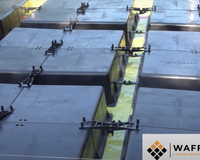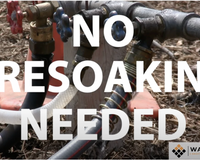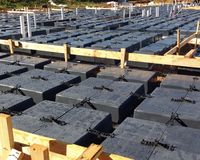Moisture is notorious for causing problems in concrete foundations and the buildings they support. Concrete is a porous material and, when exposed to water, is prone to cracking, curling, and structural damage. Here’s everything you need to know about using moisture barriers and cutoff walls to protect your foundation.
What is a vapor barrier for concrete?
In foundation construction, there are two main materials used to keep moisture from entering a foundation: Vapor Barriers and Vapor Retarders. While these two names are often used interchangeably, they serve entirely different functions. Vapor barriers are used to protect a concrete slab from moisture, and vapor retarders help insulate your building’s envelope.
A vapor barrier isn’t as permeable as a vapor retarder, meaning water can’t pass through the barrier as easily as it can the retarder. Vapor barriers are a thicker, more durable material that should not be confused when it comes time to prep your concrete pour.
The effectiveness of a given vapor barrier is measured in perms. If you’re installing the plastic barrier under a concrete slab, it is recommended that you use something with a perm of .3 or below. This means that your concrete slab vapor barrier thickness should be enough to allow .3 perms of moisture or less through the barrier.

Why do you put plastic under a concrete slab?
There are two main reasons why we use a plastic vapor barrier under a concrete slab. The first reason is to protect your slab right after you pour to help give it the best possible finish. The second reason is to provide long-term protection from moisture in your soil.
Vapor barriers help with curing
It’s always best to have full control of the moisture introduced to your slab during the drying process. Using a vapor barrier under a concrete slab ensures it’s not exposed to moisture from the soil, making it challenging to cure your slab properly.
When your freshly poured slab isn’t insulated from moisture, it can also delay your cure time. Concrete dries by removing water through its surface, and when it’s exposed to outside moisture, it won’t dry like it should.
Long-lasting protection against moisture
Moisture from your soil can wreak havoc on your home if you don’t protect it with a plastic vapor barrier under its concrete slab. As water accumulates in your foundation, it can spread to your walls, wooden floors, and produce dangerous conditions for mold or mildew.
By adding a vapor barrier or cutoff wall, you won’t have to worry about the potential damage moisture could cause to your home. Above all else, it delivers peace of mind when you know your foundation is safe.

Do I need a vapor barrier under concrete?
Yes, you should always add a vapor barrier under your concrete slab to protect your foundation from moisture. You cannot block vapor from rising through your concrete slab without an impermeable barrier.
This is not the same as protecting your home from groundwater that comes from rain or local water sources. For this, it’s best to use a cutoff wall to protect your foundation.
A cutoff wall blocks groundwater from reaching your foundation, dispersing it away from your home. It can protect against erosion, structural damage, and toxic mold growth.
You should always use a vapor barrier under concrete and only use a cutoff wall if your foundation is located somewhere that demands extra protection from groundwater.

More reasons to use a vapor barrier
Too many people make the mistake of not recognizing the importance of protecting their foundation from moisture, and it can lead to expensive problems in the future. If you’re still not convinced, here are more reasons you should never skip this step when pouring a concrete slab.
Protect your indoor air quality from the effects of moisture. With a properly installed and intact vapor barrier, you can help protect building inhabitants from harmful mold exposure or carcinogenic toxins like radon.
Improve your building envelope and put less stress on your HVAC system. One of the things your HVAC system does is remove moisture from the air. Without a vapor barrier, it can require your system to work overtime and increase your energy bills.
Avoid expensive repairs and damage to your foundation. When vapor travels through concrete, it can cause cracking or curling in your concrete slab. This is usually accompanied by signs of water damage on the building’s interior.
Some buildings are required to have a vapor barrier. Some insurers and warranties consider installing a vapor barrier as a best practice, meaning the fine print could leave contractors with liability if they skip this step.
Did you know vapor isn’t the only threat to a building’s foundation? Learn how the Wafflemat Foundation system can protect you from all of it.





